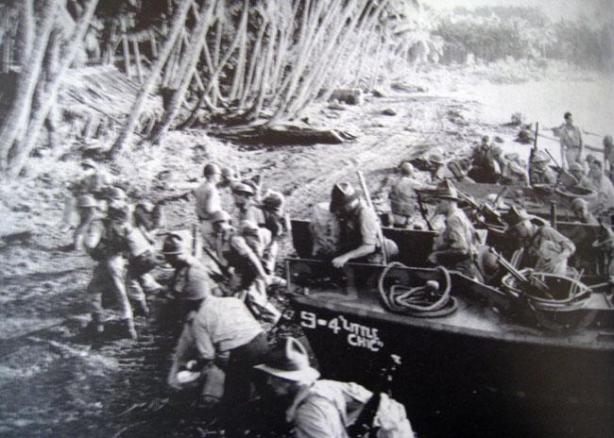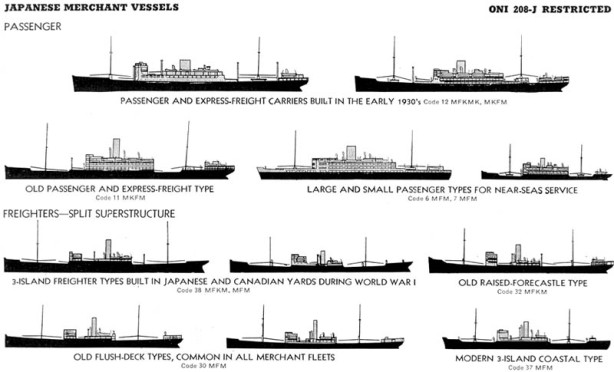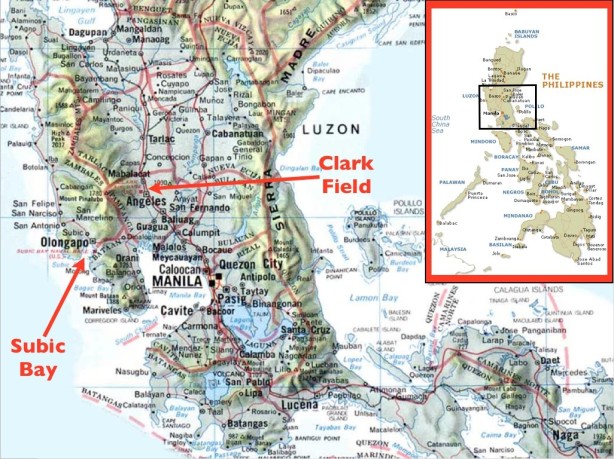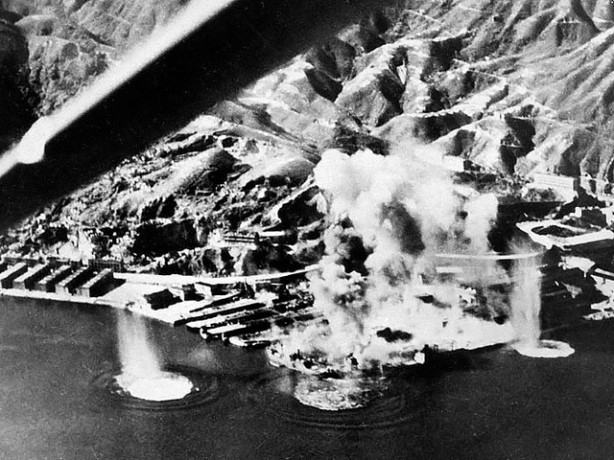The world is still at war and my father, Seaman First Class, John Thomas Ryan is still serving on the USS Hornet (CV-12).
I recently accessed a war diary on the website Fold3. This war diary provides a narrative of the Hornet’s activities during each month. Most of my posts on this blog have been based on factual sources about the war in the pacific and where the Hornet was involved; however there wasn’t always something in those sources specifically about the Hornet. I plan to go back to some of my previous posts and add some of these pieces of information. Today I added the December 1944 information.
According to the ship’s log, in January 1945 – the USS Hornet (CV-12) enters the South China Sea for strikes on Formosa, Pescaderos, Saigon, Camranh Bay and Hong Kong. According to various sources, the events of January 1945 were called Operation MIKE I and Operation GRATITUDE.
Operation Mike I was the first of seven operations, a series of American landings at Luzon between 1945-01-09 and 1945-01-31 after the conclusion of Operation KING, which was obligated by General McArthur’s insistence that he liberate the entire archipelago. MIKE consisted of seven proposed landings and other operations. Each plan was numbered, but they were executed out of sequence. Operation MIKE was followed by Operation VICTOR. It was the major American landing on Luzon, the principle island of the Philippines. On 1945-01-09, the United States I Corps and XIV Corps performed an amphibious landing at Lingayen Gulf, halfway up the west coast of the island. The Japanese responded with an aerial Kamikaze attack that failed. The operation was concluded with no major contact between the ground forces.
Operation Gratitude was a raid of the South China Sea area conducted by the United States Third Fleet between 10 and 20 January 1945 during the Pacific War of World War II. During the operation, the Third Fleet’s aircraft carriers and battleships attacked Japanese shipping in and near Indochina on 12 January. The fleet then sailed north and attacked Formosa on the 15th of the month. Further raids were conducted against Hong Kong, Canton and Hainan the next day. Further planned attacks were frustrated by bad weather, and the Third Fleet departed the South China Sea on 20 January. The Third Fleet’s raid on the South China Sea was highly successful. The American carrier aircraft and warships sank 40 Japanese ships and destroyed 110 aircraft. The Japanese succeeded in shooting down 98 aircraft, however.
FORMOSA
If you are not familiar with Formosa, it is the former name for Taiwan.
January 3 and 4, 1945
From the war diary found on the website, Fold3:
In accordance with the stated mission, first strikes were scheduled for 3 January, against Formosa and the Ryukyus. The four days enroute to launching position were spent in routine patrols, group exercises, and fueling.
Operations began with a predawn fighter sweep, launched on schedule in spite of unfavorable weather. Weather was to remain the severest obstacle during the entire cruise, and it is greatly to the credit of the fliers that missions were generally carried out under the conditions encountered.
Airborne opposition was negligible, which was to be the rule throughout the cruise. The principal targets on this and most subsequent strikes were plans on the ground and shipping underway and in the harbors. Anti-aircraft fire and weather were invariably the chief causes of casualties.
The targets assigned to the Hornet this first day, as on all subsequent strikes on Formosa, were the airfields grouped around Tainan, the Pescadores and Takao and Toshien Harbors (see map above). Frequently, under conditions of bad visibility Hornet fliers attached other fields, and shipping wherever encountered. But for the most part they remained over the assigned areas. On 3 and 4 January, the first two days of the operations, these targets were not particularly productive. The net for the two days was one plan shot down, 30 planes destroyed or damaged on the ground, 1DE, 9 AKs, 25 luggers probably sunk or damaged, and various buildings and installations bombed. There were no personnel losses during these strikes.
For me it is time for definitions:
What is a DE? The Japanese Destroyer Escort Program. The Japanese suffered crippling destroyer losses in the Solomons in 1942. While the standard Yugumo destroyer class was an excellent design, its construction took far too long to make good the Japanese losses. The Japanese Navy therefore rushed a new design into production (the Matsu class) that emphasized ease of construction and survivability. These were designated as destroyers but resembled the American destroyer escorts, being slightly smaller but faster and better armed. Further simplifications to speed up construction resulted in the Tachibana design
What is an AK? Cargo ships, together with transports, are the ultimate reason why navies exist. They are the least expensive way to transport goods over long distances, though not the fastest. A typical cargo ship of the late 1930s could carry a few thousand tons of goods at a cruising speed of perhaps 10 knots, with a fuel consumption of around 0.1 ton per nautical mile. Some of the older cargo ships still used coal instead of fuel oil.
What is a lugger? A lugger is a class of boats, widely used as traditional fishing boats, particularly off the coasts of France, England and Scotland. It is a small sailing vessel with lugsails set on two or more masts and perhaps lug topsails.
The USS Hornet (CV-12) was part of Task Force 38 in the TG 38.2
CTG RAdm Gerald F. Bogan
| CV | Hornet II, Hancock, Lexington II/GF |
| BB | New Jersey/FltF, Wisconsin |
| CA | (temporarily attached 01/11-01/12): Boston, Baltimore |
| CL | San Juan CruDiv17: Wilkes-Barre, Pasadena, Astoria II |
| DD | Trathen (from 01/05) | |
| DesRon52 | DesDiv103: The Sullivans, Miller, Owen, Stephen Potter, Tingey DesDiv104: Hunt, Marshall |
|
| DesRon62 | DesDiv123: Ault, English, Waldron, Haynsworth, Charles S. Sperry DesDiv124: Wallace L. Lind, John W. Weeks, Hank |
|
| DesRon61: | (temporarily attached 01/11-01/12): DesDiv121: De Haven II, Mansfield, Lyman K. Swenson, Collett, Maddox II DesDiv122: Blue II, Brush, Taussig, Samuel N. Moore |
|

Elements of Task Group 38.2 underway from Ulithi on 30 December 1944. Aircraft carriers are (front to back) INDEPENDENCE CVL-22, HORNET CV-12 and LEXINGTON CV-16. Cruisers at right are SAN JUAN CL-54 followed by CruDiv 17 ships. -U.S. Navy photo in NARA record group 80-G-300093

Not from the Hornet, but in the same operation. VT-4 Avenger over the mountains of Formosa, January 3, 1945.
January 5 – 7, 1945
I tried to find a map of Luzon that shows all the places mentioned below and this is the best I could find.
From the war diary found on the website, Fold3:
After fueling for a day, target was shifted to Luzon, and strikes were launched on 6 and 7 January from a position off the east coast of that Island. Conditions were much the same as at Formosa – bad flying weather and little air opposition. Five airborne enemy fighters were destroyed over the target in the two days, but there was no real fighter defense. Friendly planes roamed over the island at will. All airfields were attacked. Hornet’s assigned area was a group of fields north of Clark Field, principally Bamban and Tarlac. However, Mabalacat was frequently struck, and one sweep covered the Cagayan River Valley as far north as Aparri. Frequently the weather was so bad that only fighters in a strike would get to the target. The two days showed a score for Hornet of 25 planes destroyed or damaged on the ground, and many military trucks and several railroad locomotives strafed and burned. Two fighter pilots and a bomber pilot and crewman were lost in action on 7 January, largely as a result of the very bad visibility.

US Army 40th Division, showing American soldiers advancing on the Japanese held up in the Bamban Hills, Bamban, Tarlac, Luzon, Philippines, 1945
January 8 and 9, 1945
From the war diary found on the website, Fold3:
After Luzon, the Task Force moved back to Formosa, fueling enroute on 8 January. The first landings n Luzon were scheduled for 9 January, and there were reports of enemy shipping concentrations on the wet coast of Formosa. This proved correct, as Takao Harbor and vicinity produced many fine targets on 9 January. A few planes were strafed on the various airfields, and five locomotives destroyed, but the shipping score totaled a destroyer and 2 medium AKs blown up, a large oiler, a DE, and 6 medium freighters probably destroyed of damaged. One torpedo plane was shot down by flak over the south tip of Formosa and one Torpedo crewman was killed in his plane, also by flak.

World War II in Pictures- On January 9, 1945 the Hell Ship Enoura Maru was still in the harbor at Takao (and moored to the same buoy with a Japanese tanker making them a prime target) when aircraft from the USS Hornet attacked.
January 10 – 12, 1945
From the war diary found on the website, Fold3:
From Formosa, the Task Force steamed south to transit the Luzon Straits for the first time. Night fighters from Independence splashed two high flying bogies, probably ferrying between Formosa and Luzon in the early dawn of 10 January. Heavy weather delayed fueling on the 10th, and it was continued on 11 January. Searches were flown on this day, covering practically the entire South China Sea. Hornet’s Air Group flew three ten degree sectors to 420 miles, two fighters and one bomber in each sector. Searches were negative, and after completion of fueling, course was set for the Camranh Bay-Saigon section of the coast of French Indo-China, for a surprise shipping attach at dawn on 12 January. Two fast battleships, with cruisers and destroyers, were detached to steam ahead and destroy any fleet units found in Camranh Bay.
Predawn searches by night fighters found no major targets in Camranh Bay and the battleships and cruisers rejoined. But the air strikes up an down the coast, from Saigon and Cape St. Jacque to Tourano, produced one of the biggest shipping hauls on record. Hornet’s share of the shipping was a Katori Cruiser, a large oiler, a DE, and 2 medium freighters sunk, 7 DE’s and 9 freighters (large, medium and small), damaged, beached or set on fire. Other air groups joined in some of these attacks. Added to this were three seaplanes destroyed at Camranh Bay, and 14 land planes strafed at Tan Son Nhut field, near Saigon. One torpedo plane and crew were lost in one of the shipping strikes, and a fighter pilot made a forced landing on land. Word was subsequently received that this pilot was in friendly hands.

Curtiss SB2C-3 Helldiver aircraft bank over the carrier before landing, following strikes on Japanese shipping in the China Sea, circa mid-January 1945. Photographed by Lieutenant Commander Charles Kerlee, USNR. Official U.S. Navy Photograph, now in the collections of the National Archives (photo # 80-G-469319).

A U.S. Navy Grumman TBM-3 Avenger of torpedo squadron VT-11 from the aircraft USS Hornet (CV-12) flies past three Japanese oilers burning in Cam Ranh Bay, Indochina (later Vietnam), on 12 January 1945.
January 13 – 15, 1945
From the war diary found on the website, Fold3:
For two days after the Indo-China strikes, the Task Force was occupied chiefly in riding out the fringes of a tropical typhoon. On 13 January there was no flying at all. On 14 January, searchers were flown, and the Task Force was fueled. On 15th January, strikes and sweeps were launched against both Formosa and Hong Kong, and the China coast between. Hornet’s Hong Kong fighter sweep bagged the prize of the day, a Tess, escorted by 4 Zekes, approaching Hong Kong. All were splashed and even Tokyo Rose railed at this loss. Hornet’s CAP splashed a Jill (Ticonteroga’s CAP got 4 Zekes a little later), a destroyer was bombed at the Pescaderos, but Formosa produced little, only about 15 planes strafed and probably destroyed, on the various fields near Tainan. Of the fields near Hong Kong, only Kai Tak showed any planes, sixteen being counted, and three destroyed. There were good shipping targets in Takao Harbor, but a low ceiling plus barrage balloons and intense anti-aircraft made any attacks suicidal and they were not undertaken. One bomber water landed on return, the pilot only being recovered.
Definition time again.
What is a Tess? The United States gave names to Japanese aircraft. Tess was the name for Douglas DC-2 used by Japan.
What is a Zeke? Another American name for Japanese aircraft. A Zeke was better known as a Zero which was the Mitsubishi A6M.
What is a Jill? Another American name for Japanese aircraft. A Jill is a Nakajima B6N Navy Carrier Attack Bomber.

Heavy seas and rain on the morning of 13 January 1945. USS LEXINGTON CV-16 attempts to fuel from ATASCOSA AO-66 while a destroyer takes a heavy roll to starboard.
-U.S. Navy photo in NARA record group 80-G-299869

In an image often incorrectly attributed to Typhoon Cobra, a SUMNER-class destroyer plunges in a trough in the South China Sea on 13 January 1945. This image was taken from NEW JERSEY BB-62.
-U.S. Navy photo in NARA record group 80-G-470284
Tokyo Rose (alternative spelling Tokio Rose) was a generic name given by Allied forces in the South Pacific during World War II to any of approximately a dozen English-speaking female broadcasters of Japanese propaganda. However, Iva Toguri is the most famously linked name behind the Tokyo Rose. She was a native to Los Angeles and was stranded in Japan because she was visiting her family when the war broke out. The intent of these broadcasts was to disrupt the morale of Allied forces listening to the broadcast. American servicemen in the Pacific often listened to the propaganda broadcasts to get a sense, by reading between the lines, of the effect of their military actions. She often undermined the anti-American scripts by reading them in a playful, tongue-in-cheek fashion, even going as far as to warn her listeners to expect a “subtle attack” on their morale.

Kai Tak Airport, Hong Kong. Circa 1946, Short Sunderland Mk.V flying boats of en:No. 209 Squadron RAF (visible in the middle left of photo is ‘WQ-S’, one of the squadron’s Sunderland) parked on land and at the seaplane anchorage of en:Kowloon Bay off en:RAF Kai Tak. Also visible in the foreground is a Douglas Dakota Mk.I of en:No. 215 Squadron RAF.
January 16, 1945
From the war diary found on the website, Fold3:
On 16 January, the Task Force strikes covered Hong Kong, Canton, and Hainan. Hornet’s Air Group was assigned shipping, docks, and airfields in and about Hong Kong. Strikes on the docks and shipyards were successful. Three ships were burned and much damage done to the docks at Taikoo shipyards, Kowloon and Cosmopolitan Dockyards at Kowloon, and the Royal Navy Yard at Hong Kong were heavily hit. But the results of the strikes against ships anchored in Hong Kong Harbor were not commensurate with the effort expended or the losses. A combination of cramped terrain, intense and concentrated A/A (my guess anti-aircraft) and water too shallow for proper torpedo runs all contributed to the unsatisfactory outcome. Hornet lost 2 fighters and on torpedo with all personnel. Photos showed 2 large oilers in Hong Kong Harbor damaged by the attack, one moored at the Royal Navy Yard. Planes on Kai Tak field were strafed, and the Texaco Oil Tank at Kowloon was burned.
January 17 – 21, 1945
From the war diary found on the website, Fold3:
For the next four days, the Task Force cruised the South China Sea, fueled, flew extensive searches, but conducted no effective operations. On the night of 20 January, the Luzon Straits were transited again, this time on a northeasterly course. The CAP’s of the two other Task Groups accounted for 12 bogies destroyed during the transit, again all appearing to be ferry planes. Strikes on Formosa were ordered for the following morning.
Formosa, particularly Takao, Tainan, Pescadores area (see map at beginning of post), was by this time a familiar target for Hornet’s fliers. Shipping was not plentiful, but there were targets in Takao, Toshien, and Pescadores Harbors. Two destroyers were hit (one fresh out of dry dock at the naval base at Mako Ko, Pescadores), and three large oilers, 5 medium freighters damaged at Takao and Toshion. Three airborne fighters were destroyed, and upward of 60 destroyed or damaged on the ground. Enemy rolling stock was reduced by three more locomotives. The weather was favorable for once, and there were no losses to Hornet’s Air Group. The day was marked, however, by the only real enemy attack on the force during the entire operation. Shortly after noon, with hardly any warning from radar, CTG 38.3 reported his Task Group under attack. No planes got as far as Task Group 38.2, 10 miles distance, but in all, 28 planes were counted in the two main raids which came in. Of these, 22 were splashed, 20 by CAP and 2 by ships A/A. Hornet remained at General Quarters for several hours, but all strikes were launched on schedule. Task Group 38.2 CAP did not encounter any enemy planes.
January 22 – 31, 1945
From the war diary found on the website, Fold3:
The last strike of the cruise was against Okinawa, on 22 January. The mission was primarily photographic, and there were very few respectable strafing or bombing targets. A few luggers and fishing boats were fired by strafing, several old looking planes bombed, rocketed, and strafed on Yontan, and Le Shima fields, and various buildings and trucks destroyed. But in general the day was unproductive and uneventful. Machinato and Yonabaru fields assigned to Hornet, were completely negative. The target also clouded up in the afternoon, and photographic results were impaired. The Okinawa strike ended offensive air operations for the cruise. It has been a long and intense period for the Air Group, made more difficult by continuous bad weather. All hands were ready to return to Ulithi for replenishment, which was ordered on 23 January
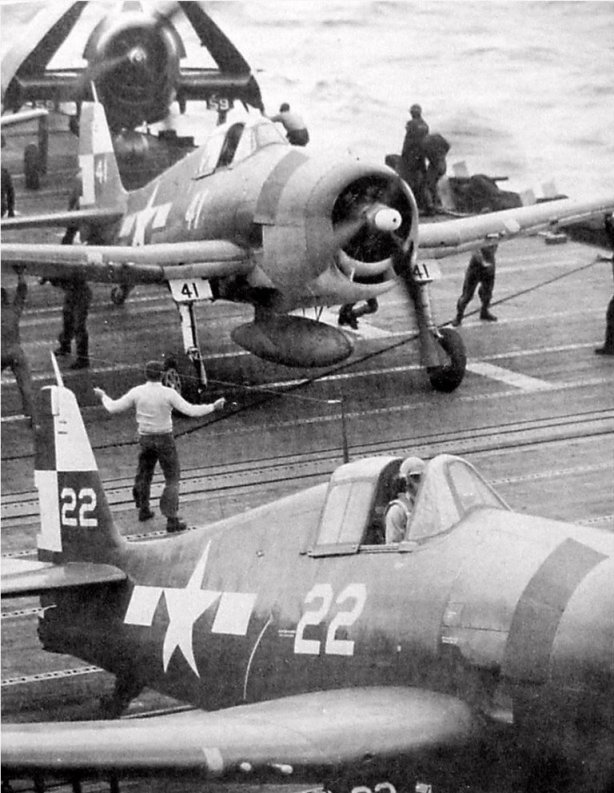
A mix of Hellcats. Flat windscreen F6F-5’s and round windscreen -3’s from VF-11 on Hornet, late January 1945, launching for strikes against Formosa.

Hornet and Independence (CVL-22) together, Jan. 25, 1945, as seen from Enterprise (CV-6).
National Naval Aviation Museum, photo # 1996.488.245.010. Robert L. Lawson Photograph Collection.
Check back next time for the Battle of Iwo Jima (February – March 1945).


